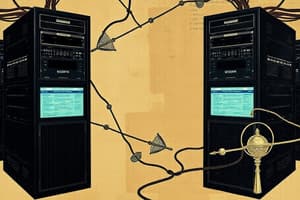Podcast
Questions and Answers
Which of the following is NOT considered an intermediary network device?
Which of the following is NOT considered an intermediary network device?
- Router
- Computer (correct)
- Firewall
- Switch
An end device is where a message originates, and it only exists at the receiving end.
An end device is where a message originates, and it only exists at the receiving end.
False (B)
What are the three broad categories of network components?
What are the three broad categories of network components?
Devices, Media, Services
Communication across a network is carried through a medium such as __________, fiber optic cables, and wireless transmission.
Communication across a network is carried through a medium such as __________, fiber optic cables, and wireless transmission.
Match the following network components with their descriptions:
Match the following network components with their descriptions:
What is the primary advantage of a packet switched network?
What is the primary advantage of a packet switched network?
Circuit-switched networks can achieve fault tolerance by allowing multiple paths for data.
Circuit-switched networks can achieve fault tolerance by allowing multiple paths for data.
What does QoS stand for, and why is it important?
What does QoS stand for, and why is it important?
A scalable network can expand quickly to support new users and applications without affecting the performance of existing _____.
A scalable network can expand quickly to support new users and applications without affecting the performance of existing _____.
Match the following aspects of networking with their descriptions:
Match the following aspects of networking with their descriptions:
What does BYOD stand for?
What does BYOD stand for?
Collaboration tools such as Cisco WebEx are mainly used for personal communication.
Collaboration tools such as Cisco WebEx are mainly used for personal communication.
Name one application that can be accessed using cloud computing.
Name one application that can be accessed using cloud computing.
Cloud computing allows businesses to extend their capabilities on _______ and is delivered automatically to any device.
Cloud computing allows businesses to extend their capabilities on _______ and is delivered automatically to any device.
Which of the following devices can be used under BYOD?
Which of the following devices can be used under BYOD?
Private clouds are intended for the general public to access.
Private clouds are intended for the general public to access.
Applications and services in a public cloud are available through a ________ model.
Applications and services in a public cloud are available through a ________ model.
Match the following cloud types with their descriptions:
Match the following cloud types with their descriptions:
What is one advantage of cloud computing for smaller companies?
What is one advantage of cloud computing for smaller companies?
What is a major priority for businesses and educational institutions?
What is a major priority for businesses and educational institutions?
Flashcards are hidden until you start studying
Study Notes
Overview of Network Components
- A network can range from a simple connection between two computers to a complex global network.
- Network infrastructure includes three main components: devices, media, and services.
End Devices
- End devices are the sources or destinations of messages in a network.
- Data flows from one end device through the network and arrives at another end device.
Intermediary Network Devices
- Intermediary devices connect end devices and include switches, routers, wireless access points, and firewalls.
- Their roles include regenerating and retransmitting signals, managing network pathways, and notifying devices of errors.
Network Media
- Communication happens through various media enabling message transfer from source to destination.
- Common media types include metallic cables (copper), fiber optic cables (glass), and wireless transmission.
Network Representations
- Network diagrams, or topology diagrams, visualize networks and devices.
- Important components in diagrams include Network Interface Card (NIC), physical ports, and interfaces.
Topology Diagrams
- Topology diagrams illustrate the physical layout and connections between devices.
- Redundancy is crucial for fault tolerance; multiple paths enhance reliability in packet-switched networks.
Reliable Network Scalability
- A scalable network allows for quick expansion to accommodate new users and applications without degrading performance.
- Standards and protocols help ensure networks can scale effectively.
Quality of Service (QoS)
- QoS is essential for managing voice and video traffic, ensuring reliable content delivery.
- Without sufficient bandwidth or QoS configuration, users may experience interruptions during live transmissions.
Network Trends: Online Collaboration
- Collaboration tools like Cisco WebEx facilitate real-time interactions for joint projects.
- Online collaboration is increasingly prioritized in business and education.
Network Trends: Cloud Computing
- Cloud computing enables users to store personal data and access applications via the Internet.
- It allows businesses to scale on demand, utilizing remote data centers for better resource management.
Types of Clouds
- Public Clouds offer services to the general public on a pay-per-use basis.
- Private Clouds provide applications and services for specific organizations, enhancing security and control.
Network Security: Security Threats
- Security is vital for all network sizes, addressing both external threats (viruses, hacker attacks, data theft) and internal user risks (unintentional breaches, BYOD vulnerabilities).
Network Security: Security Solutions
- Security measures should be layered, incorporating multiple solutions. Basic protections for small networks include antivirus software and firewalls.
- Larger networks require advanced measures like dedicated firewalls, access control lists (ACL), intrusion prevention systems (IPS), and virtual private networks (VPN).
Conclusion: Exploring the Network
- Networks and the Internet significantly influence daily life, accommodating various scales from small two-device connections to vast systems like the Internet.
- Key network characteristics include fault tolerance, scalability, quality of service support, and security measures.
Studying That Suits You
Use AI to generate personalized quizzes and flashcards to suit your learning preferences.




